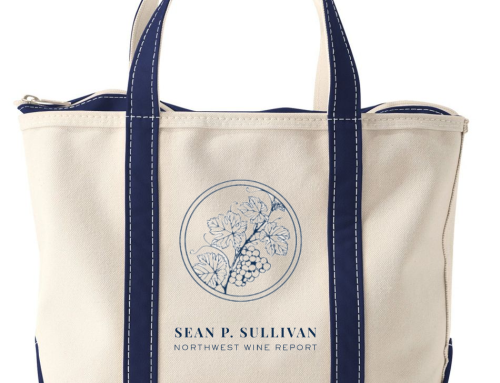
“That was the first thing I really did in the business,” McClellan recalls.
The year was 1982. McClellan was a student at the University of Washington, studying pharmacy. Having worked in agriculture since he was 14, McClellan was asked by his father, James, and his partner Herb Hendricks to assist in planting what would become Seven Hills Vineyard, the first commercial Merlot plantings in Walla Walla Valley.
“My dad said, ‘Why don’t you come on out and grab a hold of this,’” McClellan recalled. “We planted the first four-acre block of Merlot in the valley.” Cuttings came from Fairacre Nursery.
McClellan went on to found Seven Hills Winery in 1988 and made his first Merlot that same year. He says Seven Hills Vineyard can be a special spot for the variety.
“I like the balance we get in Merlot at that site,” McClellan says. “Right kind of soil. Right elevation. The mesoclimate is great. The control of water status. In the end what that adds up to is we can get a ripe style Merlot that has color and an age-able level of phenolics, so we can make a higher end Merlot that will last.”

McClellan remembers the vintage well.
“’93. Super cool year. Among the four coldest in my career. We had great acid retention, and in cooler years I think Merlot up here [at Seven Hills] really performs well. It’s got more of a classical almost European acid/phenolic flavor profile in those years. In cold vintages, you get some stunningly well-aging Merlot off of Red Mountain as well.”
McClellan says that in great vintages and great sites, Washington Merlot can last 20 years. What makes a great Merlot site in McClellan’s mind?
“Merlot from my experience just doesn’t like too much stress. You can’t treat it like Cabernet. It likes a little more forgiving soil structure, whereas the Cabs up on these bony basalt ridges can handle that stress and they benefit from it, I think Merlot up there, it’s almost too stressful an environment.”
He notes that Walla Walla Valley provides an abundance of excellent sites for Merlot.
“I really like what I see in the silt loam soils in the Walla Walla Valley, anywhere from Seven Hills up into the foothills by Les Collines at about 1,200 feet there. They are a little higher in clay content because of the higher rainfall. I think you can make quite a nice, dense style of Merlot.”
The 2017 Seven Hills Vineyard Merlot was actually the inspiration for the 2020 Washington Merlot Challenge, and this was my bottle for February. A little over half the fruit comes from 1991 plants, over a third from the original 1982 plantings, and the rest from 1997 plantings. There’s opulence to the raspberry and earth aromas and flavors but also a sense of precision, detail, and restraint. It shows all of the beauty, grace, and structure of the variety in the state.
“I think ‘16 and ‘17 are great Merlot vintages,” McClellan says. “They were typical Growing Degree Days and a little larger crop load, but the wines have turned out wonderfully. Those are a fun couple of Merlot years.”
No doubt that recent, warmer vintages, such as 2013 through 2015, have, at times, challenged Merlot in some locations in Washington. McClellan expects warming temperatures to eventually change where Merlot is grown in the state.
“Eventually, I think if climate continues to change, Merlot will be moving up in altitude or moving North,” he says. While where it is grown might change, McClellan believes the soil types growers seek out should remain the same.
“I think we still should be looking for silt loam soils with varying degrees of clay content. Those are the best types of sites.”
Nearing 40 years since McClellan put the first Merlot vines into the ground in the valley, he is still exploring new directions with the variety.
“We did some new clonal plantings. Those are starting to bear fruit this coming year. This Clone 9 is grown at about 1,500 feet in the foothills above Walla Walla Vintners. I’m really, really impressed with how that clone does in that soil and location. It has beautiful color and intensity. That’s pretty exciting.”
Long-term, is he intrigued about the possibilities of Italian Merlot clones in the valley.
“Tasting these high-end Merlots from Northern Italy, it’s interesting to see what a whole different winemaking culture is doing with Merlot. The texture of them and thickness. It has got me excited about if we could try and bring some of those flavors over to what we do here.”
No doubt if he does, wine lovers will be tasting and enjoying the wines for many years to come.
Picture of Casey McClellan courtesy of Crimson Wine Group.







Leave A Comment